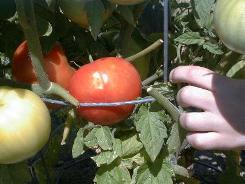
| Home | Products | Exhibits |
| Store | Overview | Application |
| Links | Brochures | Contact |
| MSDS |
The results illustrated below are easily accomplished with our Organic Garden Kit.
Click on Picture to Enlarge
Beefsteak tomato's grown at T&J Enterprises were ripening by the beginning of August. These tomato's are two months early. They usually don't ripen until the end of September and frequently are still green by the first frost. All of our Beefsteak tomato's ripened before the middle of September. A second crop of tomato's is now growing on those plants. I have never seen that happen before. We are lucky to get one crop of Tomato's before the end of the year. Again, Mycorrhiza inoculation has made a significant difference with our tomato's this year.
1998's growing season has taken a turn for the large size in the garden of Bill and Joanie Flynn of Spokane, Washington. To Joanie's right is a Pear Tomato plant. One teaspoon of Mycorrhiza Inoculant was used on this plant. It looks like it might be several plants, but there is only ONE. The vines are up to eight feet long. The plant spans from the far left to just behind Joanie. Do you think this tomato plant is worth the 21 cent cost for a teaspoon of Mycorrhiza Inoculant? Bill and Joanie thought that was money well spent! They had never seen a Tomato plant that extensive before. The fruit produced from that plant was plentiful and excellent in taste.
Don't waste your money and time on those wire cages to prop up your Mycorrhiza Inoculated Tomato plants. They won't hold the plant's weight. I have seen several mangled wire cages this year. When a plant grows six feet high and has 60 large tomato's on it, you need to find a better way to support those plants.
Metal fence posts work well in holding up the weight of these large tomato plants. It's important to keep the fruit off the ground away from potential pests that crawl around there.
Good advice for starting up tomato plants from seed:
"Start out by growing tomato seedlings in seed starting trays. When the first true leaves appear, transplant the tomato seedlings into individual pots (three inch) and bury the entire seedling up to the top two leaves (strip off the other leaves). When the plants are 3-4 inches high, go up 6-inch pots, again burying everything so the stem sprouts numerous roots. If the weather is slow to warm up, you may end up repotting three times. It is important that you NEVER allow a tomato plant to become rootbound in a pot or quit growing rapidly. If a tomato transplant is slowed in growth, it never puts out much more in the way of primary root growth. Experienced growers have found that tomato transplants (even those put out in the ground) have about 8 weeks from germination to form their root structure. Beyond that, it will produce hair roots, but not much more and that is why adding Mycorrhizae fungi to such plants will help ensure more nutrients are brought into the plants."
(The above paragraph is copyrighted by Doreen Howard, doreenh@ticon.net and is reprinted here with permission.
T&J note: If you are NOT starting your own tomato plants it will be difficult for you to predict whether or not a commercially grown plant was allowed to become root bound before it was transplanted into larger sized pots. More often than not, commercially grown plants sold at most retail outlets are root bound when you purchase them. What Doreen has written above is significant because root structure development on a root bound tomato plant will slow down significantly and will not recover. When BioVam is applied to such plants, the mycorrhiza fungi can grow several inches out into the soil from the roots of such plants. That hyphae is fragile and is thinner than a human hair. If a thick, nutrient rich, organic mulch is applied around your plants, soil disruption that breaks up the hyphae network and additional fertilizer additions will be unnecessary.
Product Catalogue
Privacy, Return, Refund Policy
© Copyright 1998 - by T & J Enterprises. ALL RIGHTS RESERVED.